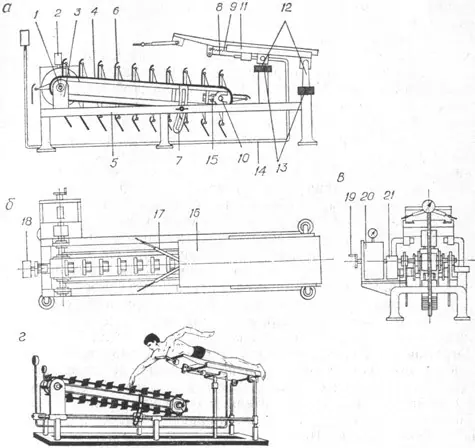In this article we will analyze a unique training device for special training of a swimmer. All the world's leading athletes practice swimming exercises on it, and its main task is to bring your technique to the peak of perfection.
The device is designed to develop strength qualities and improve the technique of stroke movements of the arms in the swimming variant: front crawl. The strength training of a competitive level swimmer requires mandatory training on this simulator. If you have not practiced key techniques and exercises on this training device, then most likely you simply have no business even thinking about serious swimming competitions, and your level of training is still very far from perfect...
Using a simulator to develop the physical qualities of a swimmer opens up wide possibilities for varying the amount of load placed on the “working” muscle groups under specific conditions of competitive swimming (Fig. 1). The design of the simulator is as follows (Fig. 1, a, b, c). The conveyor 4 is located between two parallel shafts 1 and 10, located in the same plane. Shaft 1 is mounted on bearings pressed into support posts 3 mounted on the supporting frame 5. Shaft 1 is connected through a gearbox 21 to the hydraulic brake shaft 20 mounted on the frame 5. The hydraulic brake consists of a vane pump, container and pipelines. The degree of braking on shaft 1 is set on the hydraulic brake by throttle 19. Shaft 10 is seated in the bearings of the tension device 15 of the conveyor. The tensioning device is installed in bracket 7, fixed to the frame. The bracket with a clamping handle has several positions for installing the tensioning device, thereby achieving different angles of inclination of the conveyor to the horizontal plane. Along its length, at equal distances from each other, on axes fixed in the transverse direction, blades 6 are installed, the rotational and transverse (along the length of the axis) movement of which is limited by springs (not shown).
The movement of the platform along the guide rails is recorded by the measuring head of the dynamometer 18 using connecting rods 8, 14. At the front edge of the platform, elbow stops 17 are hinged, consisting of hinged sliding levers.
Let's consider the principle of operation of the simulator. The student, preparing to perform swimming exercises on it, lies with his chest on the platform so that the shoulder girdle and upper chest are in front of the platform. The palm of the hand is placed on the shoulder blade. By raising or lowering the racks or rearranging the tension device in the bracket, the angle of flexion in the elbow joint is selected. The limiters are installed in such a way that when the forearm is perpendicular to the longitudinal axis of the body in the middle of the stroke, the peripheral end of the limiter is 2...3 mm from the inside of the elbow joint. When pulling the conveyor back under the pressure of the palms on the shoulder blades, the student on the platform moves forward a distance corresponding to the traction force with each stroke. The dynamometer provides immediate information about the degree of arm force and the coordination of the pulling forces of the two arms. As the conveyor is pulled, the pump forces liquid into a system that has a throttle, which regulates the load. The liquid passes through the throttle and again enters the container, making a circular motion. A pressure gauge 2 is installed in front of the throttle, informing the student about the change in pressure in one or another phase of the stroke. Limiters help control the correct position of the elbow joint relative to the hand: if the position is incorrect, the inner side of the elbow joint will touch the peripheral end of the limiter, which serves as a signal that the execution is incorrect rowing movements. Performing strength exercises is shown in Fig. 2, g.
Post Views: 103


